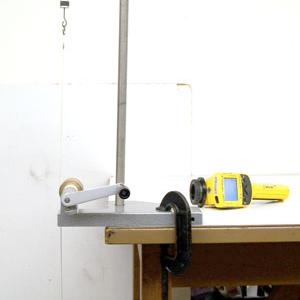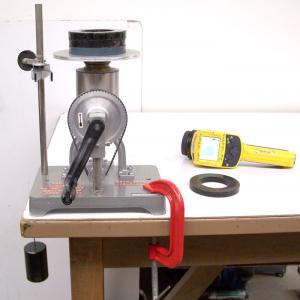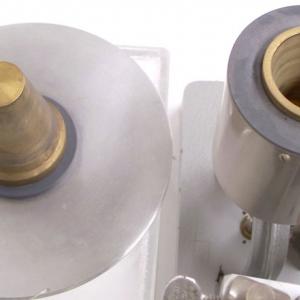College of Liberal Arts & Sciences
4B60.20 - Mechanical Equivalent of Heat - Friction Method
The new CENCO equivalent of heat apparatus is probably the easiest to set up and operate in the classroom. The thermistor that is internal to the drum is very sensitive and will show very good temperature rises with less than 50 turns. You will need to compare the multimeter resistance reading to the enclosed chart to be able to convert to centigrade temperature.
NOTE: Both of these apparatus have been modified for lecture demonstration and should be used only for "show and tell" or to make qualitative measurements. Use either the infrared camera or one of the infrared thermometers from lab for heat detection.
For demo purposes, the PHYWE apparatus may be used with or without the spring scale attached to the strap that is wrapped around the brass cylinder. Hang 4 to 10 kg from the strap and then crank the handle a hundred times. Monitor the temperature rise of the brass cylinder with the infrared camera.
The CENCO design uses the "friction cone" as the heart of the apparatus. The cone and cup are a matched set and carefully machined to provide maximum friction.
DO NOT drop or damage either of these in any way.
Also note that this apparatus has to have at least one or two of the ring masses applied to the top plate to prevent the cone from "walking" out of the cup when the apparatus is rotated at high speed. The temperature rise of the cone may be monitored from the top with the infrared camera.
- Michael Boleman, "Mechanical Equivalent of Heat — Software for a Thermistor", TPT, Vol. 46, #2, Feb. 2008, p. 92.
- Thomas B. Greenslade Jr., "Nineteenth‐Century Measurements of the Mechanical Equivalent of Heat", TPT, Vol. 40, #4, Apr. 2002, p. 243.
- F. Neff Weber, "Measuring the Mechanical Equivalent of Heat—Mechanically", TPT, Vol. 30, #8, Nov. 1992, p. 507.
- Mario Iona, "Power and Apparent Power", TPT, Vol. 19, #4, Apr. 1981, p. 218.
- Bruce Jones, "A Stirring Experiment", TPT, Vol. 18, #9, Dec. 1980, p. 671.
- Chandler M. Dennis Jr., "Newton's Law of Cooling or is Ten Minutes Enough Time for a Coffee Break?", TPT, Vol. 18, #7, Oct. 1980, p. 532, also A Potpourri of Physics Teaching Ideas - Fluids and Heat, p. 113.
- Edsel M. Langdon and Gerald M. Straks, "'How to Cool a Book by its Cover' Revisited", TPT, Vol. 14, #7, Oct. 1976, p. 443, also A Potpourri of Physics Teaching Ideas - Fluids and Heat, p. 112.
- J.A. van den Akker, "How to Cool a Book by its Cover", TPT, Vol. 13, #6, Sept. 1975, p. 324, also A Potpourri of Physics Teaching Ideas - Fluids and Heat, p. 111.
- Robert Everett Vermillion, "How to Cool a Book by its Cover", TPT, Vol. 13, #3, Mar. 1975, p. 165, also A Potpourri of Physics Teaching Ideas - Fluids and Heat, p. 111.
- Thomas B. Greenslade Jr., "Joule's Mechanical Equivalent of Heat Apparatus", AJP, Vol. 92, #4, April 2024, p. 298.
- John L. Horst and Monroe Weber, "Joule's Experiment Modified by Newton's Law of Cooling", AJP, Vol. 52, #3, Mar. 1984, p. 259.
Disclaimer: These demonstrations are provided only for illustrative use by persons affiliated with The University of Iowa and only under the direction of a trained instructor or physicist. The University of Iowa is not responsible for demonstrations performed by those using their own equipment or who choose to use this reference material for their own purpose. The demonstrations included here are within the public domain and can be found in materials contained in libraries, bookstores, and through electronic sources. Performing all or any portion of any of these demonstrations, with or without revisions not depicted here entails inherent risks. These risks include, without limitation, bodily injury (and possibly death), including risks to health that may be temporary or permanent and that may exacerbate a pre-existing medical condition; and property loss or damage. Anyone performing any part of these demonstrations, even with revisions, knowingly and voluntarily assumes all risks associated with them.



